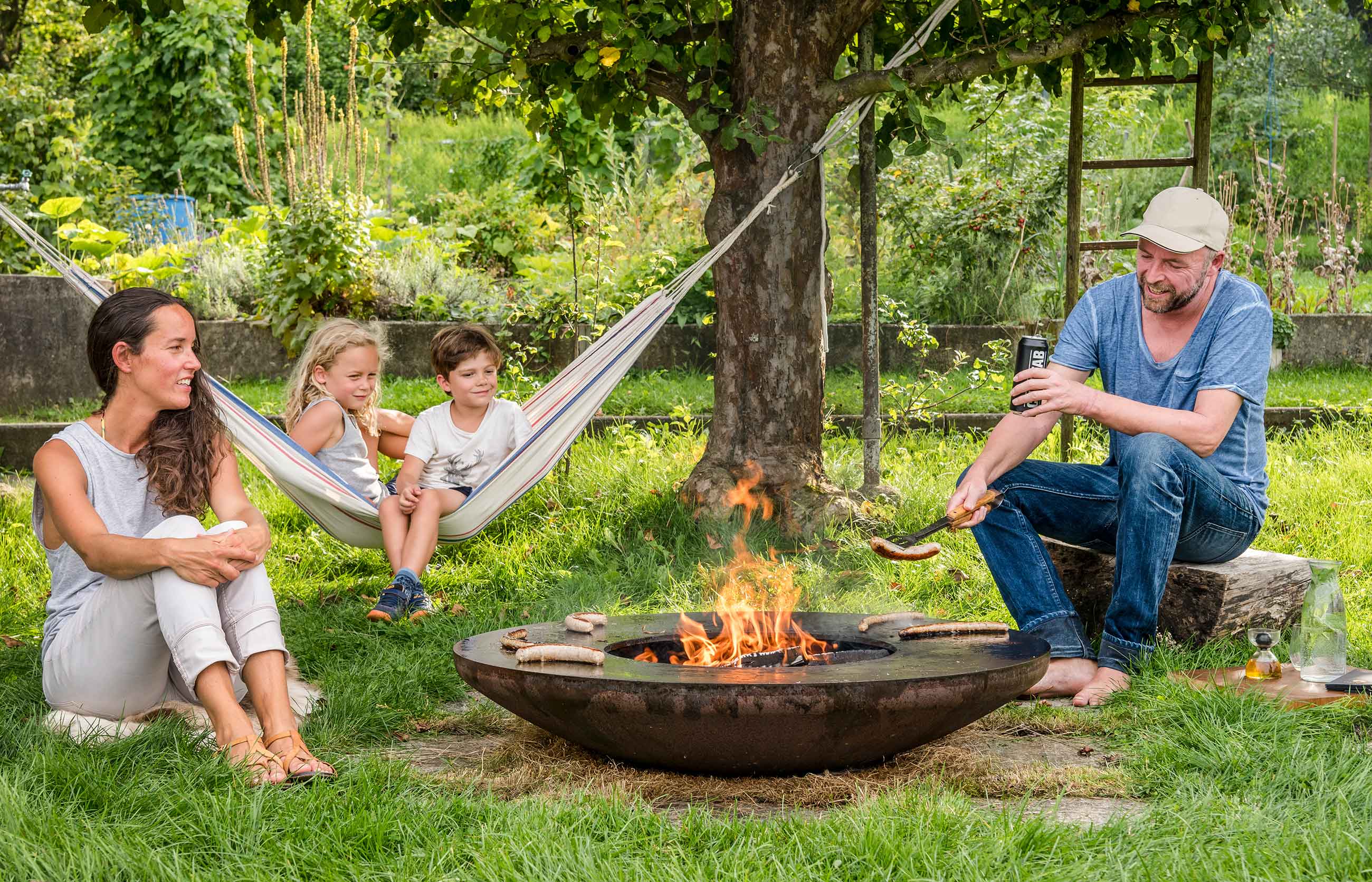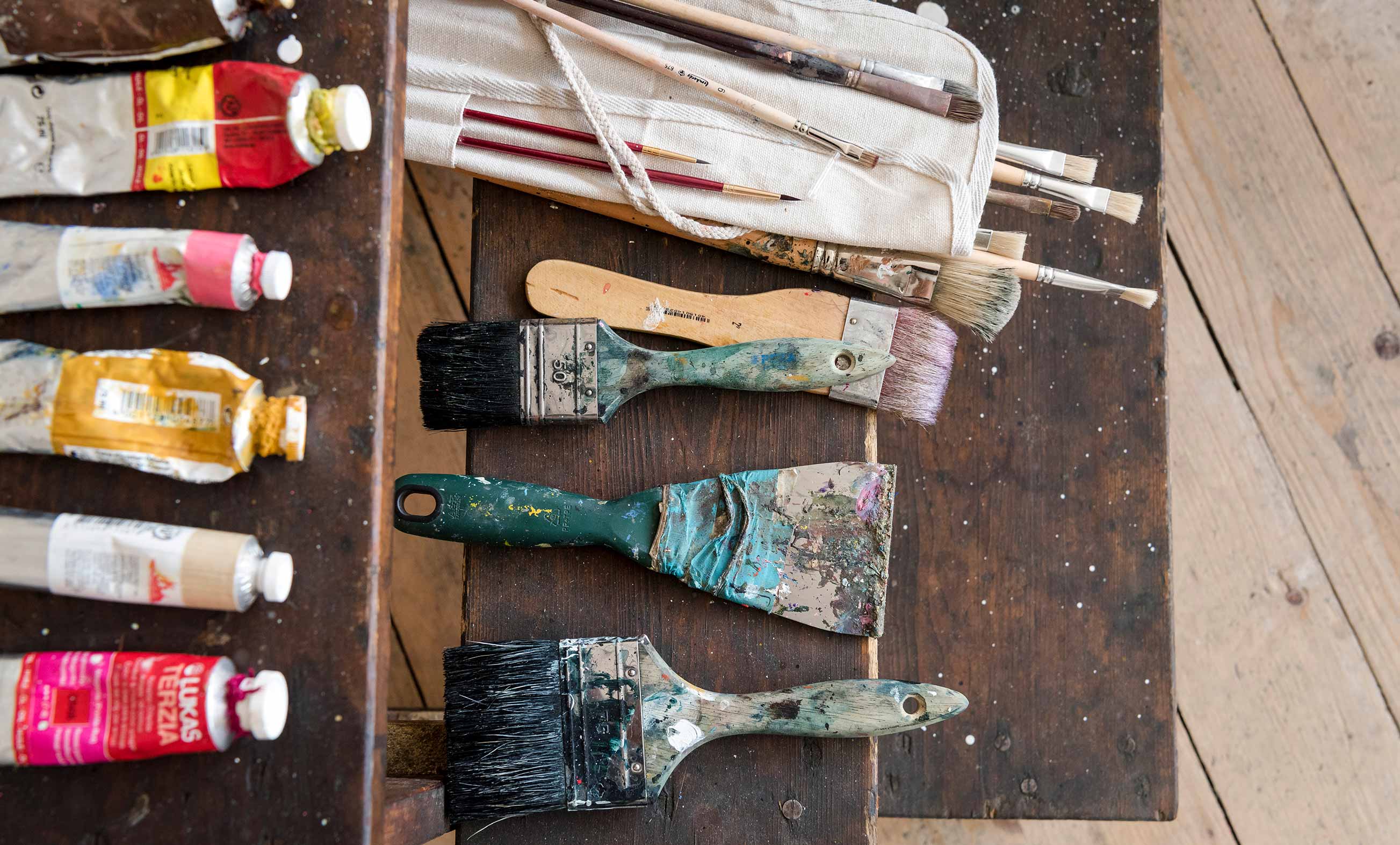
Gefe-Ambroschütz studio
«Our vision was inspired by images of hours spent sitting around a campfire looking into the flames.»
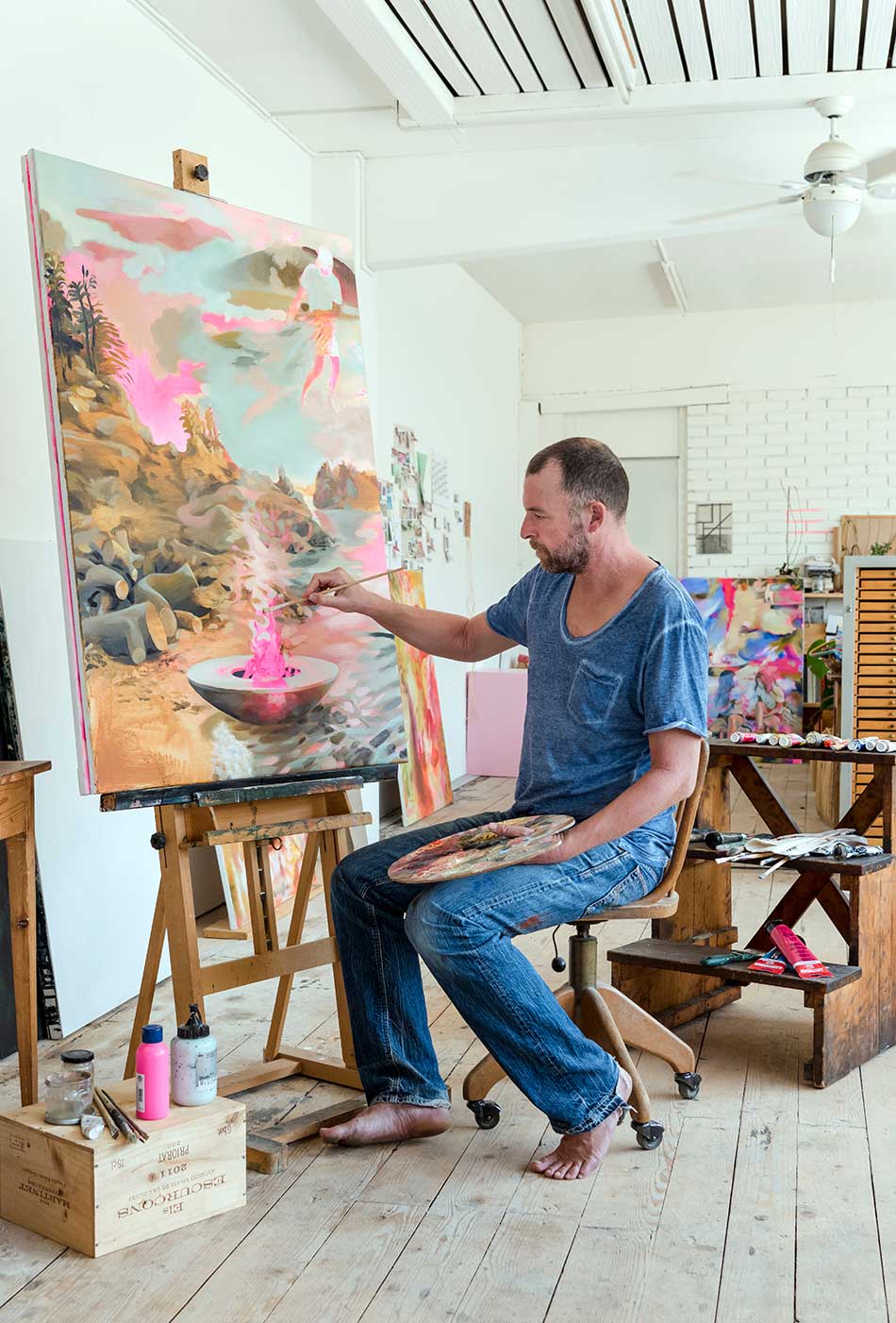
What does your everyday life look like right now?
ANDREAS
Seeing as we are both self-employed here in Zurich and thus able to organise our own working days, we basically arrange everything around our son’s timetable. Our studio is close by, some days we also work from home, and so everything fits together nicely. I think it’s also important for us to be able to go about things with a certain calmness. When I’m drawing and painting, I need a space in which I can also switch off and listen to music.
JULIA
I’m a mother, a designer and a lover of wild herbs, who also enjoys observing human behaviour. Our eight-year-old son has taught us many things, and made us more conscious about the way we interact with other people and our perception of children and ourselves. We are all students and teachers at the same time, and I try to live my life with this in mind. I organise presentations at Maria Kenessey schools. For the past three years, I’ve been assisting in a wild herb kitchen. My creative and artistic work actually began in my dad’s sculpting studio when I was a child. I studied graphical design and have now been working in a more traditional manner as a painter, graphic artist and illustrator for about three years.
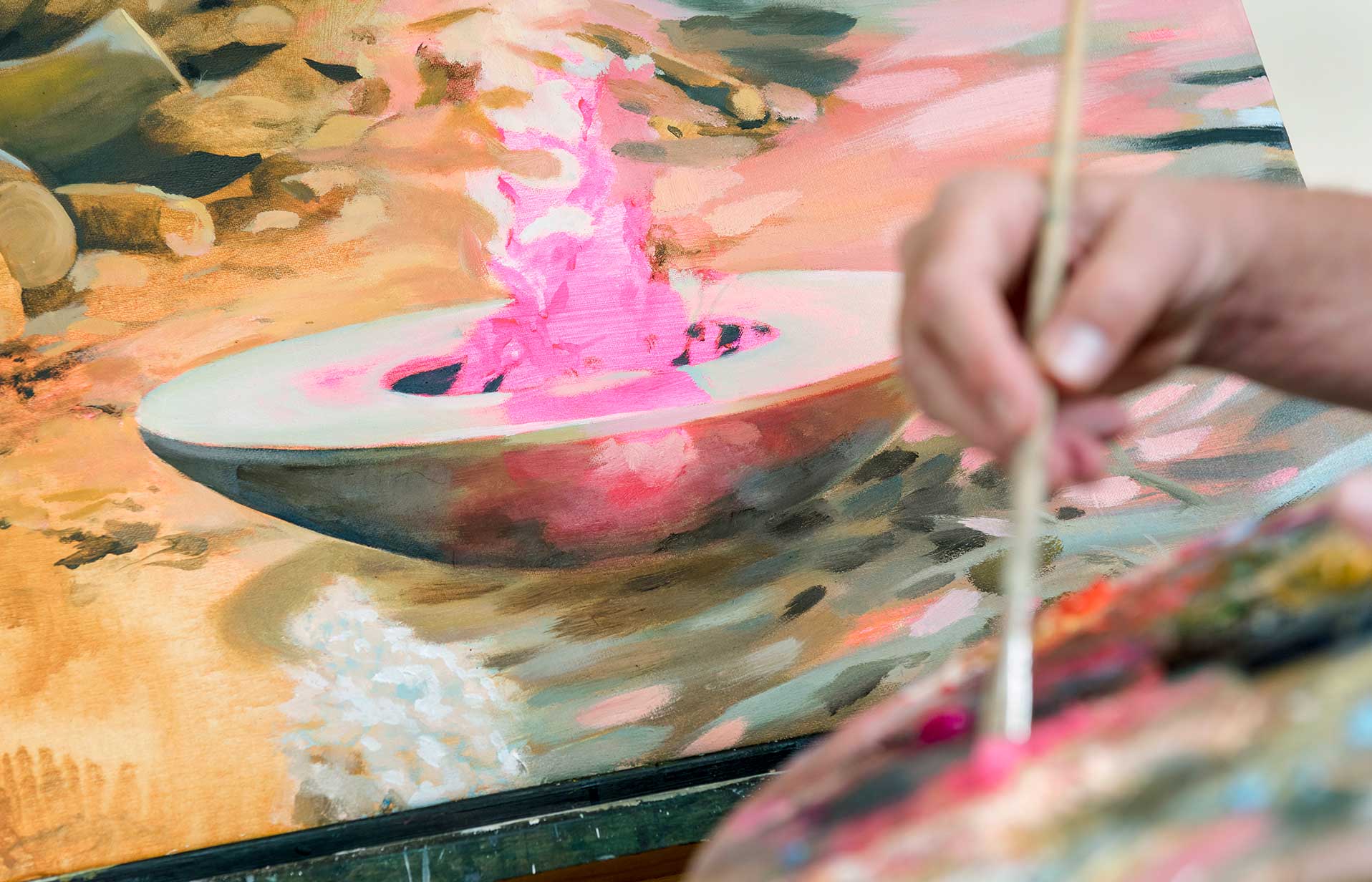
What is the motivation for your work?
ANDREAS
I think it’s great when people contact me about a painting because they’ve seen my work and like it. I then listen to all their wishes before turning to my visual world for pictorial inspiration. After all, it’s about the trust people place in me and the opportunity to create a work of art that offers both a powerful and personal experience.
JULIA
I like the fact that I’m able to let everything flow into a picture. Everything that surrounds me in my daily life is given space, even in commissioned works, sometimes simply in my thoughts or in the image, and in the best case in both. I love manual and intellectual work, and I enjoy combining the two. The process of drawing or painting offers an opportunity to recharge my creative batteries and to look inwardly, giving me energy, and I’m extremely grateful for that. Work should boost your energy, not drain it. From time to time, I’ll go through crises, question fundamental practices and principles or be annoyed when Andreas criticises something, even though I know he’s right. Actually, I’ve started announcing when I’m open and not open to criticism. These sources of friction and frustration are challenging, but it’s all part of the plan. In fact, I need challenges, as they make everything more exciting.
How did you become acquainted with the Feuerring?
ANDREAS
I have to admit that I’d never heard of it until I met Andreas Reichlin. That was one of those fortunate coincidences that life sometimes throws our way. I’d taken some pictures for a cantonal art exhibition in Schwyz to Georg Sidler (lithographer), who was planning to photograph them for the catalogue. My father drove me to Küssnacht and seeing as I still needed a large cardboard envelope, he suggested stopping by the Kreienbühl print shop, as he’s friends with the owner. Actually, I’d grown up in the house next door, but hadn’t been back there for about 30 years. Luckily, Andreas Reichlin and Georg Sidler were there working on their amazing cookbook set FEUER & RING. Andreas told me that he had an idea he’d like to talk to me about and would get in touch.
JULIA
In the bar of Papiersaal in Zurich, there are two large chandeliers featuring numerous lampshades, which were printed with our «moth» illustrations back in 2015. In the runup to this job, we’d talked at length with our client about various light sources, fireplaces, light temperature and the fact that moths are always attracted to light. After completing the moth illustrated lampshades, we decided to spend an evening with our son at Papiersaal to enjoy the full aesthetic pleasure afforded by the finished light sources. Quite by chance, Beate Hoyer and Andreas Reichlin were also sat at the bar and we got talking. In the January, during our first meeting at our studio in the Binz, Beate and Andreas gave us a fascinating insight into the Feuerring. They showed us their cookbooks and their newsletter. The 2015 edition featured the Feuerring in a quarry. I’d been to this quarry, which belongs to my uncle, as a small child. In fact, my father had spent half of his childhood there, instead of attending kindergarten and school. I too had loved being in the quarry, surrounded by huge, imposing stone giants, which I’m sure have many tales to tell in their stored memories. For me personally, the start of the «Feuerring» project was, therefore, extremely pleasant. The first time I visited Andreas and Beate at their studio in Immensee, the variously shaped and unfamiliar aesthetic fire vessels appeared to me like large monumental ceramic bowls. Each form has its own character, and also its own sound. My son, Joseph, and I had to try out all the sounds of these charming, voluminous resonating bodies at once to find out which singing bowl we liked best. We used a stick to drum out a beat on each metal body. The sounds differed greatly and reverberated for a long time, like a church bell.
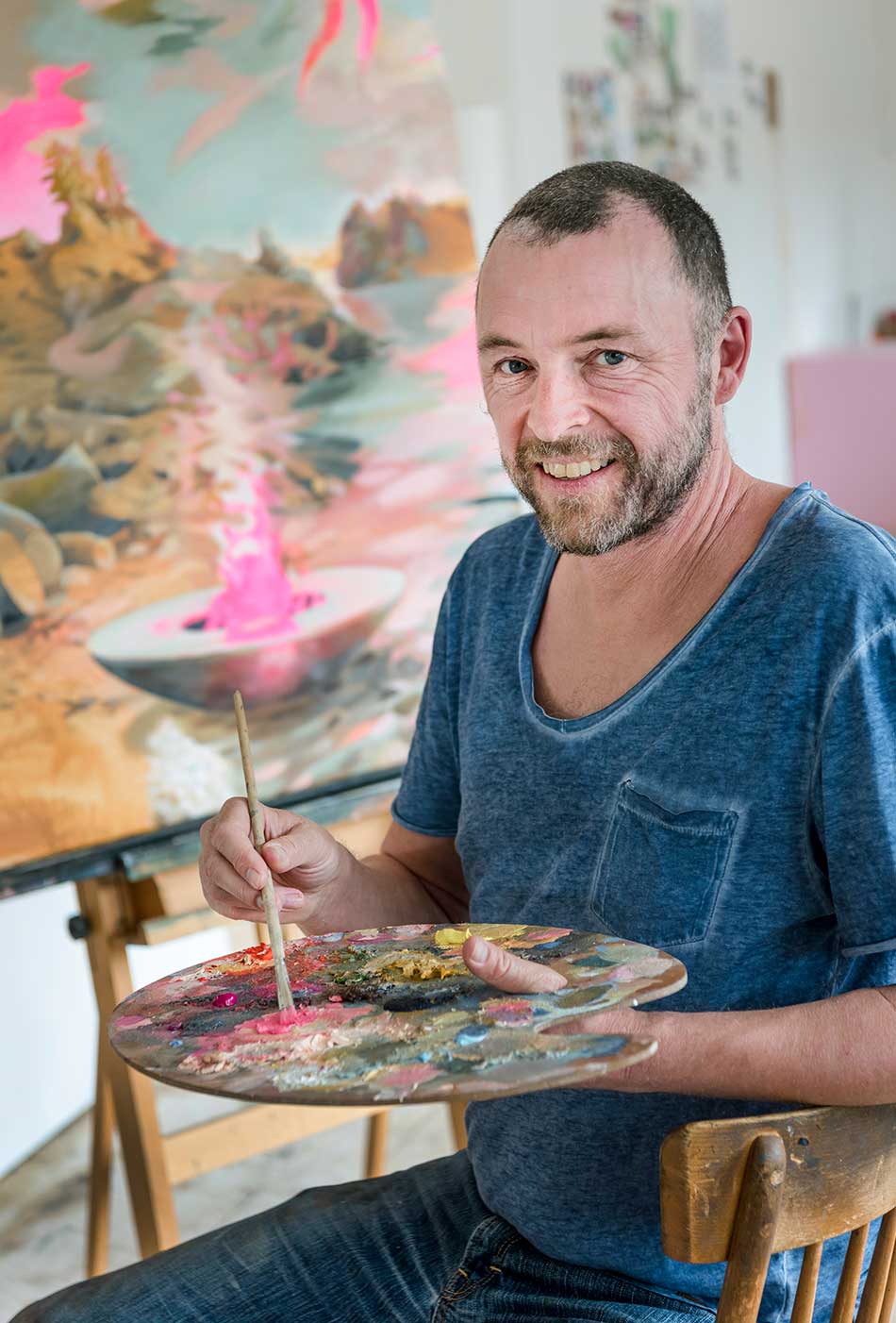
What was the challenge when it came to painting the Feuerring in various locations?
Andreas
It was a novel assignment for both of us. A series of images of an object that could be used in various ways, even in advertisements. Our aim was to do something artistically challenging without losing touch with reality. The first goal was to come up with a suitable visual language, and this was a key reason for me to work with Julia. I found the style of my previous images too contemplative to match the power of the Feuerring. That’s why it quickly became clear to us that we needed to paint largeformat images.
Julia
The Feuerring is first and foremost a discovery and an invention. We realised that we wanted to create a new visual language for a discovery of this nature. In other words, we didn’t want to simply craft it from some stylistic repertoire. It demanded innovation and something new. In terms of content, fire emerged as the main topic. Fire and food have been connecting people ever since time began. Fire and food are two of the most essential things that humans know and need, and we wanted to build on this. It takes fire to combine the past with the present, fire never changes, even though it flickers differently each time. The fireplace or vessel and the people sitting around it continue to develop over generations. We believed it was important for the topic of fire to run through all of the images like a red thread, thereby capturing the period of time from archaic fire pit to presentday gatherings around the Feuerring. Since we wanted to create eight to ten images, we, along with Andreas and Beate, assigned a distinctive element or state to each image with regard to fire and the Feuerring: Ignition, generations, music and dance, light, food, warmth, landscape, community, cycle. From a form perspective, it soon became obvious that we are both interested in the controlled and the uncontrolled or in sharpness and blurriness. We wanted to control certain aspects of the images while leaving others to chance. We made this choice independently. Then it was a matter of dedicating ourselves to developing the underlying structure of the image, sketching and composing images that contain the afore-said aspects: The topic of fire, the individual states, planned and unplanned, in order to finally integrate the Feuerring quite naturally into the image while using it to transform archaic fire into its presentday state. For us, they were also the criteria that we could use to monitor ourselves throughout the process. During this phase, we were able to unearth inspirational things. And managed to create an archive of our own material, images and photographs and those of others. At some point you’ve been provided with enough stimulus and you’re just raring to go. All the fragments, be it inspirational material or conversations and personal experiences with the Feuerring, laid the foundations for the eight to ten images.
Andreas
Our vision was inspired by images of hours spent sitting around a campfire looking into the flames. When you do this, you’ll always come across new images.
Which experiences have you had personally with the Feuerring?
Andreas
I encountered the Feuerring for the first time on Andreas’ patio: I was immediately fascinated by the fact that you can actually get a roaring fire going in such an object. The more you can integrate the Feuerring into your everyday life, the better; if you're completely at home around it, the Feuerring is in the best place possible. I’d been invited over and I really enjoyed the food. We’ve had a Feuerring in our back garden since last spring. My experience with it has been: Fire, food and social life are all celebrated with lots of devotion. Usually at a barbecue party, you can divide those present into the guests and the hosts, the ones preparing the food. With the Feuerring, people gather around the fire and roles become blurred, since everyone has the chance to participate. What I like best is when passive guests become fully-fledged fire-makers and cooks.
Julia
I’ve been assisting a wild herb chef for three years. I enjoy collecting, cooking and eating everything edible that I come across while walking through the forests and meadows. In the wild herb courses, I’m always able to guide the group that’s cooking around the fire. I just love this. Fire does me good; it transforms many things. On our plot of land in Friesenberg, every Feuerring meal becomes a real experience. The Feuerring stands in front of our old apple tree and next to the old, dilapidated garden shed. We like to keep things pretty simple there. When I make a wild herb salad, I use the large bowl in which I wash up over the fire at the end. Recently, we cooked a five-course meal on the Feuerring, and most of the ingredients came directly from the garden. Each menu was prepared in a bowl from which everyone ate together. I like it when everyone stands closely and eagerly around a bowl, with an impatient fork in their hand, or when the bowl is passed around and only one person can eat at a time; it all becomes a little anarchic and pretty raucous. There’s nothing better than cooking and eating around the Feuerring, somehow everything is just perfect. People can’t wait to spend time together around the Feuerring, cooking, experimenting, experiencing - and in the end everyone goes home with flickering memories and having enjoyed a spectacular taste explosion.
